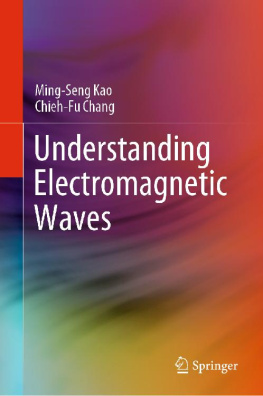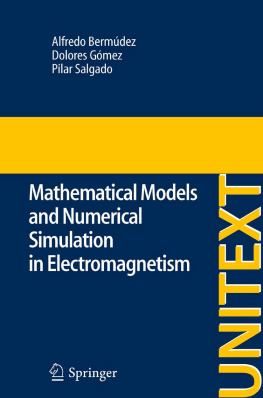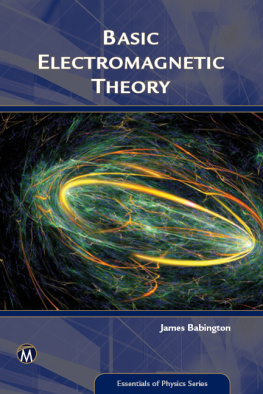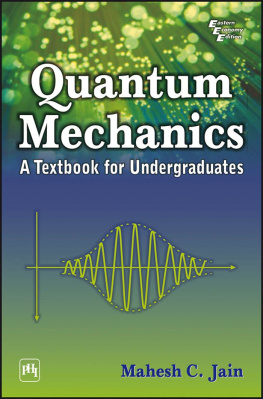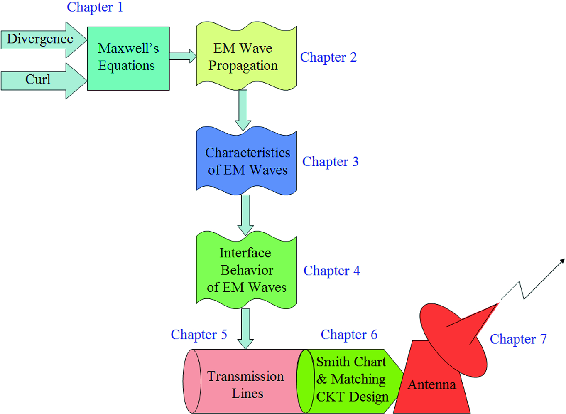Ming-Seng Kao and Chieh-Fu Chang
Understanding Electromagnetic Waves
1st ed. 2020
Ming-Seng Kao
National Chiao-Tung University, Hsinchu, Taiwan
Chieh-Fu Chang
National Applied Research Laboratory, National Space Organization, Hsinchu, Taiwan
ISBN 978-3-030-45707-5 e-ISBN 978-3-030-45708-2
https://doi.org/10.1007/978-3-030-45708-2
Springer Nature Switzerland AG 2020
This work is subject to copyright. All rights are reserved by the Publisher, whether the whole or part of the material is concerned, specifically the rights of translation, reprinting, reuse of illustrations, recitation, broadcasting, reproduction on microfilms or in any other physical way, and transmission or information storage and retrieval, electronic adaptation, computer software, or by similar or dissimilar methodology now known or hereafter developed.
The use of general descriptive names, registered names, trademarks, service marks, etc. in this publication does not imply, even in the absence of a specific statement, that such names are exempt from the relevant protective laws and regulations and therefore free for general use.
The publisher, the authors and the editors are safe to assume that the advice and information in this book are believed to be true and accurate at the date of publication. Neither the publisher nor the authors or the editors give a warranty, expressed or implied, with respect to the material contained herein or for any errors or omissions that may have been made. The publisher remains neutral with regard to jurisdictional claims in published maps and institutional affiliations.
This Springer imprint is published by the registered company Springer Nature Switzerland AG
The registered company address is: Gewerbestrasse 11, 6330 Cham, Switzerland
Preface
This book adopts a different approach to help students learn electromagnetic waves.
We believe that the most effective way for undergraduate students to learn EM waves should begin directly with Maxwells equations, especially when the course takes only ONE semester, so that students can grasp the core ideas of EM waves instantly. Therefore, we begin with Maxwells Equations in Chap. to lay down the solid background of EM waves.
Unlike traditional EM textbooks, which try to cover all the materials including static Electromagnetism and inevitably make students learn Maxwells Equations at the latter half of the course, our approach avoid this significant drawback since undergraduate students usually take General Physics which already introduces static Electromagnetism. Besides, most EM textbooks make college students difficult to learn EM waves because they usually emphasize mathematics and formulate the principles in a complete and rigorous way. It makes students spend a lot of time and effort learning mathematics instead of physics. In contrast, we try to introduce EM waves in a more heuristic way. For example, in the beginning of each topic, we introduce each fundamental principle in a simple and understandable way. Usually it is an example in our daily life or something one can imagine or see. Then we develop the concept step by step with acceptable mathematics for undergraduate students. Moreover, we provide just-enough mathematics so that students can concentrate on physical insights of critical concepts and parameters.
This book is organized as the following flowchart (next page):
In order to achieve our goal described above, in the beginning of Chap. , we introduce two principle operators of Maxwells equations: divergence and curl. After students get the ideas of divergence and curl, the physical meaning and mathematical principles of Maxwells Equations are provided to help them obtain the relevant concepts and insight.
After learning Maxwells Equations, we proceed to study EM waves based on these equations in Chap.. These chapters provide background knowledge for students to access advanced topics and various applications of EM waves.
In Chap. , we introduce antennas which are the key elements in a wireless communication system. We start from the simplest dipole antenna and then develop useful principles step by step. It ends with reciprocity theorem depicting the relationship between transmitting antennas and receiving antennas.
This book contains seven chapters given below:
Chapter Maxwells Equations
Chapter EM Wave Propagation
Chapter Characteristics of EM Waves
Chapter Interface Behavior of EM Waves
Chapter Transmission Lines
Chapter Smith Chart and Matching Circuit Design
Chapter Antenna
These chapters include the most important knowledge which undergraduate students need in EM waves. Through the study of these contents, we believe students will have a solid background in EM waves and be ready to get into high frequency circuit design as well as wireless communication systems.
Ming-Seng Kao
Chieh-Fu Chang
Hsinchu, Taiwan
Contents
List of Figures
Fig. A.1 Illustrating dot product of two vectors
Fig. A.2 Illustration of line integral
Fig. A.3 Illustrating line integral of a closed curve
Fig. A.4 Illustration of surface integral
Fig. A.5 Illustration of volume integral
Fig. B.1 The electric field produced by a positive charge
Fig. B.2 The electric field produced by a negative charge
Fig. B.3 Illustration of magnetic force on a moving charged particle
Fig. B.4 Magnitude of magnetic force with respect to the angle between magnetic field and moving direction of a charged particle
Fig. C.1 A dielectric medium without external electric field
Fig. C.2 A dielectric medium with external electric field
Fig. C.3 Dielectric polarization caused by external electric field
Fig. C.4 Illustration of the induced electric dipole inside a dielectric medium
Springer Nature Switzerland AG 2020
M.-S. Kao, C.-F. Chang Understanding Electromagnetic Waves https://doi.org/10.1007/978-3-030-45708-2_1
1. Maxwells Equations
Ming-Seng Kao
(1)
National Chiao-Tung University, Hsinchu, Taiwan
(2)
National Applied Research Laboratory, National Space Organization, Hsinchu, Taiwan
Ming-Seng Kao (Corresponding author)
Email:
Abstract
Maxwells equations are the key to understand electromagnetic (EM) waves because these equations summarize the most important and useful knowledge of EM fields. In order to help readers get the key easily and quickly, two mathematical operators: divergence and curl, are introduced by ignoring lengthy mathematics but focusing on their physical meanings. Unlike traditional approach, we provide a lot of examples and illustrations to help readers catch the core ideas.
Furthermore, we introduce Maxwells equations in two steps: physical perspective first, and then mathematical perspective, so that readers can catch the core ideas effectively. Once readers have a good understanding of Maxwells equations, a solid background for learning EM waves is established!

